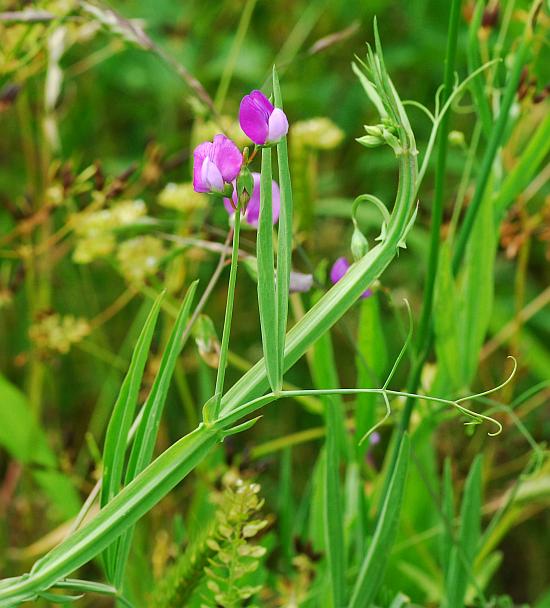Lathyrus hirsutus L.
Caley Pea

Introduced
CC = *
CW = 3
MOC = 14
© SRTurner
Lathyrus hirsutus L.Caley Pea | |
 |
Introduced CC = * CW = 3 MOC = 14 |
© SRTurner |
|
Family - Fabaceae/Faboideae Habit - Annual forb with a shallow taproot, the roots not producing tubers. Stems - Trailing, ascending, or climbing, to 1 m, often branched at the base, glabrous or sparsely and inconspicuously hairy, angled or narrowly winged, the wings to 2 mm wide.
Leaves - Alternate, even-pinnately compound with 2 leaflets, the petiole 2-4 cm long, broadly winged, the tendrils branched. Stipules 7-20 mm long, 1-3 mm wide, narrowly lanceolate, the basal lobe 3-10 mm long, narrowly triangular. Leaflets 2-9 cm long, 4-18 mm wide, narrowly elliptic to linear or oblong-lanceolate, angled at the base, angled to a bluntly or sharply pointed tip, the midvein sometimes extended into a minute sharp point at the very tip, glabrous.
Inflorescences - Solitary flowers or clusters of 2-3 flowers, the stalk 3-10 cm long, usually extending past the attachment of the flowers as a short bristle, the flower stalks 4-6 mm long.
Flowers - Calyces with the tube 2-3 mm long, glabrous or sparsely appressed-hairy, the 5 lobes 2-4 mm long, subequal, narrowly ovate to ovate. Corollas papilionaceous, 9-14 mm long, pink to bluish-purple, sometimes appearing bicolorous. Stamens 10, 9 of the filaments fused and 1 free nearly to the base. Filaments with the fused portion 5-6 mm long, the free portion 2-3 mm long. Ovary densely hairy, the hairs developing pustular bases.
Fruits - Legumes 2-4 cm long, 6-8 mm wide, narrowly oblong, strongly flattened, conspicuously hairy, the hairs with pustular bases, 5-10-seeded. Seeds 3-4 mm long, globose to slightly angular, not flattened, the surface finely wrinkled, brown.
Flowering - May - June. Habitat - Forest margins, fields, pastures, ditches, railroads, roadsides, open disturbed areas. Origin - Native to Europe. Other info. - This attractive species is commonly cultivated for soil improvement and livestock fodder. It sometimes escapes cultivation, particularly in southern counties, but is generally not common in Missouri. It is found in scattered locations in southern and western regions of the U.S., most commonly in states directly to the south of Missouri. The plant is recognized by its conspicuously winged stems, leaves having two leaflets and a branched tendril, and hairy fruits. The hairs on the fruits develop pustular bases as the pods mature, lending the distinctive "spotted" appearance shown in the above image. The plant is somewhat weedy but would do well in cultivation if kept in check. Photographs taken off Hwy 106, Shannon County, MO., 5-17-03 (DETenaglia); also at Coon Island Conservation Area, Butler County, MO, 5-19-2014, and at Otter Slough Conservation Area, Stoddard County, MO, 5-29-2020 (SRTurner). |